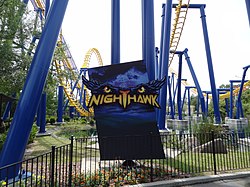| Nighthawk | |
|---|---|
| Previously known as Stealth (2000–2003) at California's Great America Borg Assimilator (2004–2007) | |
 | |
| Carowinds | |
| Park section | Thunder Road |
| Coordinates | 35°06′10″N80°56′30″W / 35.10278°N 80.94167°W |
| Status | Removed |
| Opening date | March 20, 2004 |
| Closing date | December 18, 2024 |
| Replaced | Carolina Sternwheeler Riverboat |
| California's Great America | |
| Coordinates | 37°23′46″N121°58′14″W / 37.396166°N 121.970476°W |
| Status | Removed |
| Opening date | April 1, 2000 |
| Closing date | September 2, 2003 |
| Cost | US$17,000,000 |
| Replaced | Yankee Clipper |
| Replaced by | South Bay Shores |
| Nighthawk at California's Great America at RCDB | |
| General statistics | |
| Type | Steel – Flying |
| Manufacturer | Vekoma |
| Model | Flying Dutchman |
| Lift/launch system | Chain lift hill |
| Height | 115 ft (35 m) |
| Drop | 103 ft (31 m) |
| Length | 2,766 ft (843 m) |
| Speed | 51 mph (82 km/h) |
| Inversions | 5 |
| Duration | 1:50 |
| Max vertical angle | 53° |
| Capacity | 1000 (Currently 312) riders per hour |
| G-force | 4.3 |
| Height restriction | 54–81 in (137–206 cm) |
| Trains | 2 trains with 6 cars. Riders are arranged 4 across in a single row for a total of 24 riders per train. |
| Nighthawk at RCDB | |
Nighthawk was a flying roller coaster located at Carowinds. Constructed by Vekoma, it was located in the Thunder Road section of the park. The roller coaster originally opened as Stealth at California's Great America on April 1, 2000. In 2003, Paramount Parks decided to relocate the roller coaster to Carowinds. It reopened as Borg Assimilator – the first coaster in the world to be themed to Star Trek – on March 20, 2004. After Cedar Fair (now Six Flags) purchased Carowinds in 2006, the Paramount theming was soon removed from the park, and the ride was renamed Nighthawk.
Contents
- History
- California's Great America (2000–2003)
- Carowinds (2004–2024)
- Ride experience
- Track
- Layout
- Theme
- Trains
- Incidents
- See also
- References
- External links
On December 18, 2024, Carowinds announced the permanent closure and removal of the ride. [1]


